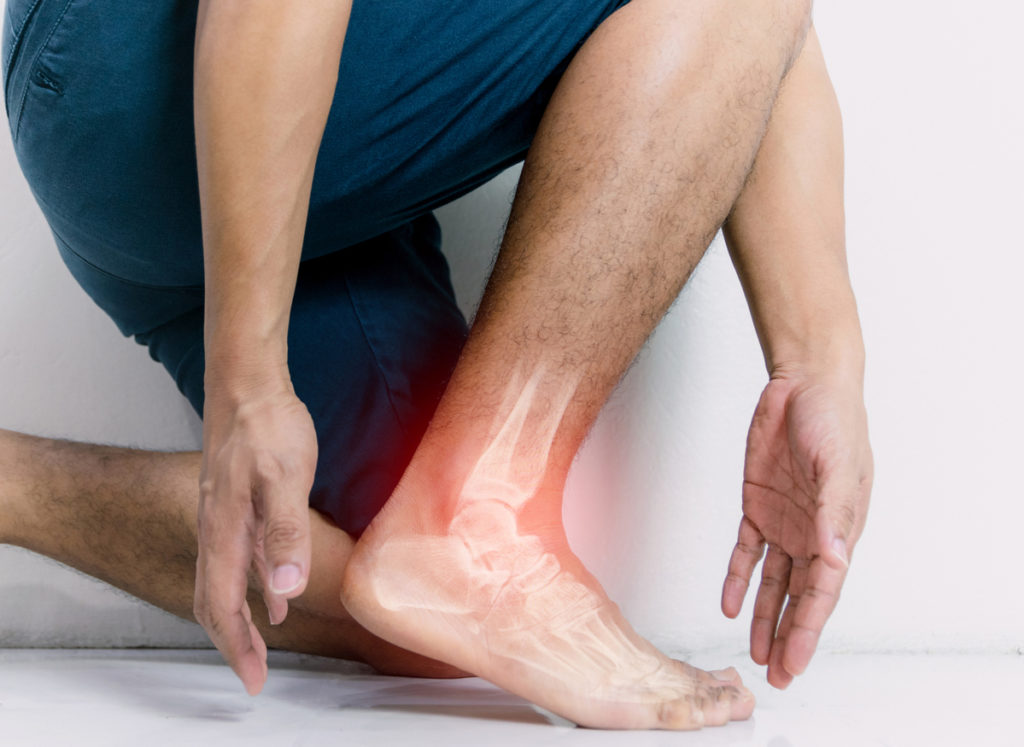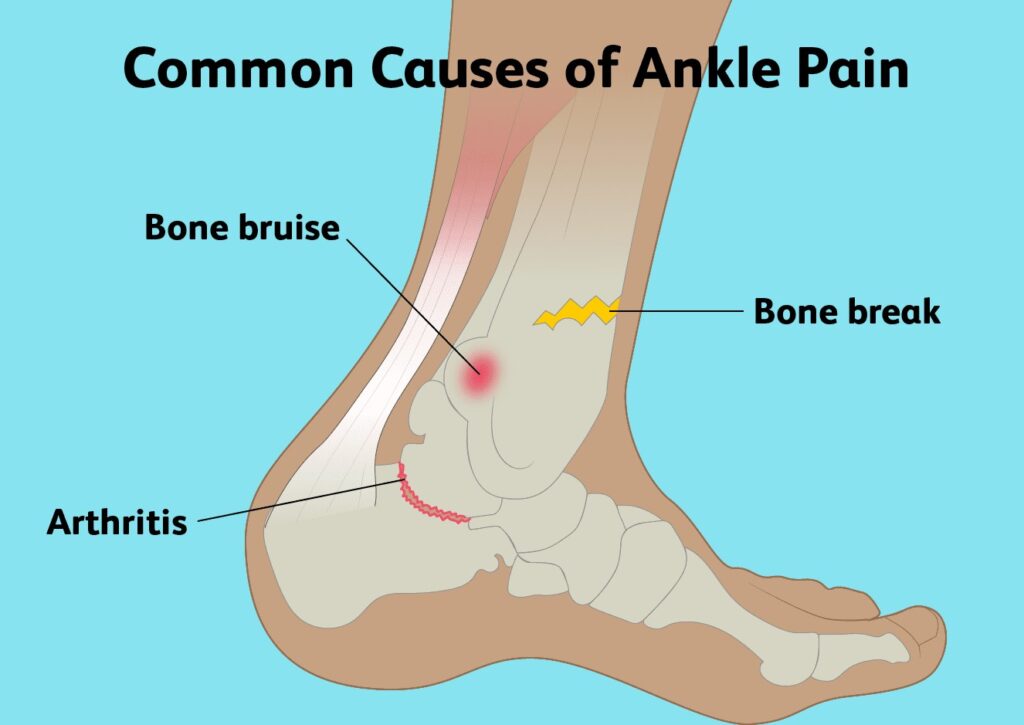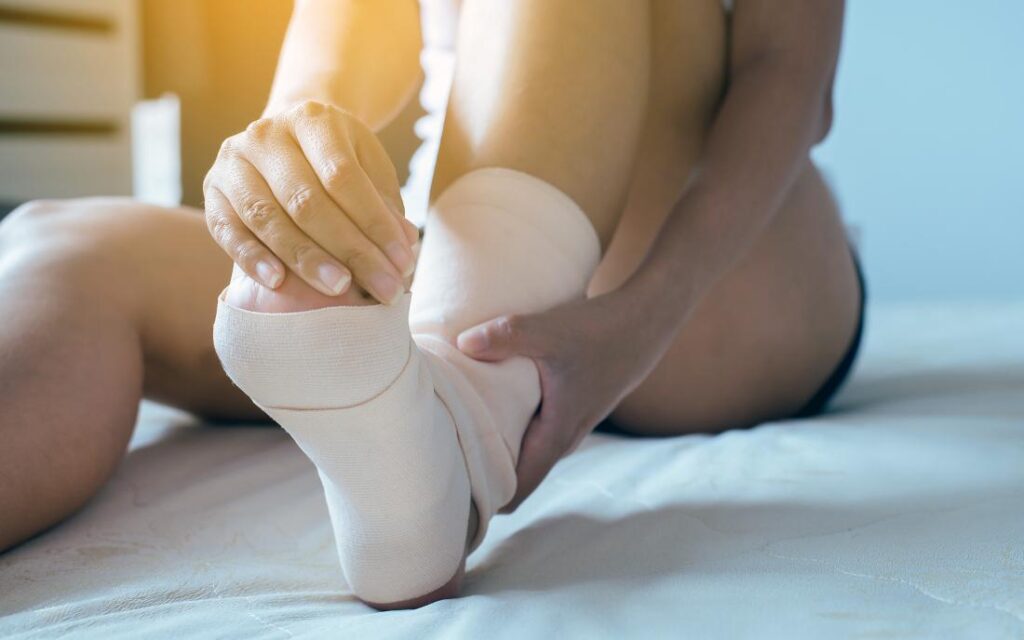ANKLE PAIN
The ankles are more important than you would think. Ankle joint is a complex system that almost constantly keeps us balanced while standing up. You might experience pain in and around your feet or ankles at some point in life. Any kind of pain or discomfort affecting any part of the ankle leads to ankle pain.
Ankle joint is the most complex, hard-working and stressed joint of your body. It is made up of 26 bones and 33 small joints connected together by soft tissue made up of muscles, tendons, ligaments, nerves, and blood vessels. Ankle joint is a hinged joint. This helps in movement of foot in 2 main directions – away from the body or plantar flexion and toward the body or dorsiflexion.
Injury, arthritis and normal wear and tear are the most common causes of ankle pain. You could feel pain or stiffness around the ankle depending on the cause. The ankle might swell making it difficult to put any weight on it. Most sprains in the ankle are lateral sprains. Sprain occurs when your foot rolls, causing your outside ankle to twist toward the ground, thus stretching or ripping the ligaments.

Ankle pain and injuries are common. You are prone to have ankle pain if:
- You are over age 65
- You play sports or do activities that involve jumping
- You do side-to-side movements or quick changes in direction
- You are obese or have extra weight
The ankle pain is graded as per the severity of the pain:
- Grade I or Mild: This represents stretched ligaments but not torn. There might be stiffness but the ankle feels stable.
- Grade II or Moderate: Multiple ligaments are partially torn. Joint is not totally stable with stiffness and swelling.
- Grade III or Severe: Multiple ligaments are totally torn. The ankle is unstable with a lot of pain.

CAUSES OF ANKLE PAIN
Ankle pain can result from various conditions and injuries. Some of the important reasons for ankle pain are:
- Bursitis: Bursae are fluid-filled sacs that cushion your bones when they move. If these fluid sacs are irritated or inflamed bursitis is caused.
- Fractures: Bones might break or fracture, due to an accident or injury. Factures might range from mild to severe causing ankle swelling and pain.
- Sprains: It is a common cause of ankle pain. An ankle sprain occurs due to stretch or tear of the ligaments. Sprained or twisted ankles happen due to rolling of the ankle forcefully out of its normal position.
- Tendonitis: Tendons (soft tissues) might be irritated and inflamed causing injury called tendonitis. Tendons help to connect muscles to bones. Sometimes, a tendon can tear causing Achilles tendon rupture.
- Arthritis: Osteoarthritis is the most common cause of ankle pain. It is caused by wear and tear on the ankle joints. Older people are more prone to osteoarthritis.
- Gout: It is uric acid build up causing crystal deposition in the joints. This would cause sharp pain in the ankle. Pseudo-gout is a condition similar to gout but instead of uric acid deposition calcium deposits in the joints. The symptoms would include pain, swelling, and redness.
Other problems such as arthritis, flat foot, gout and infection such as cellulitis or osteomyelitis.

SYMPTOMS OF ANKLE PAIN
Below symptoms are common
Throbbing pain
Stiffness and swelling
Discoloration
Redness with warmth and tenderness
Looseness of the joint.
Swollen skin over your ankle
Fever or chills
Pain when standing on your tiptoes
Doctors would order an imaging test including an X-ray, CT or MRI scan that would create images of bones and soft tissues to check for damage. If the doctor doubts an infection biopsy is recommended. Healthcare provider removes a sample of tissue and sends it to a lab to check for bacteria.

TREATMENT OF ANKLE PAIN
Initially even a relatively benign ankle injury might be quite painful. Ankles provide support and stability to your body every time you stand, walk, or run. Ankles perform key functions and support weight, thus they are susceptible to overuse and injury.
Treatment regime for ankle pain mainly involves self-care such as:
- RICE method – This involves Rest, Ice, Compression and elevation that helps reduce inflammation and pain.
- Rest –Taking a break and rest is required when you have ankle pain. Also, avoid certain activities causing stress to your ankles. This helps in preventing pain and swelling.
- Ice – Applying ice reduces inflammation and pain. Ice wrapped in fabric or ice slush bath helps in reducing the pain. Apply the ice to your hurting ankle for 15 to 20 minutes. Repeat this every two to three hours during the day.
- Compression – To reduce the swelling wrap your ankle lightly (not tightly) with an elastic bandage.
- Elevation – To reduce the swelling, place your ankle at a level above your heart. Elevation works due to gravity, which helps to drain the excess fluids from the ankle toward the heart in the circulatory and lymphatic system.
- Medication – Over-the-counter medicine are prescribed to relieve mild to moderate ankle pain. Painkillers such as ibuprofen (Advil, Motrin IB, others) and naproxen sodium (Aleve) help ease pain and aid healing. Apart from painkillers certain topical ointments also help in relieving pain in the ankle. Even with the best self-care, your ankle swelling, stiffness or pain will not subside. The pain and swelling increases particularly in the morning or after you’ve been active, for several weeks.
- Exercise – Exercise is the best way to reduce pain and stiffness in the ankles. It is important to exercise in the morning if your feet or ankles are stiff in the morning. This helps to loosen up the muscles. A warm bath or shower would help ease stiffness. It is advised not to do strenuous amounts of exercise initially. You should start gently and slowly, then build up the amount you are doing. Once each exercise becomes easier or more comfortable you can increase its quantity. You might feel a slight ache while moving your ankle during exercise, this is normal. But, if these movements make your pain worse or are causing bursts of more intense pain, you should immediately stop and consult your doctor.
- Orthotics – These are helpful in relieving the stress on the muscles. Orthopedic shoe insert, foot or ankle brace help in realigning your joints and keep pain and discomfort away. These can be customized as per your requirement such as degrees of stiffness or size. The inserts support different parts of the foot and redistribute your body weight, thus relieving your pain. Ankle braces work in the same manner.
- Injections –If the pain and inflammation does not subside with pain killers, doctors would recommend steroid injections. Steroid injections contain corticosteroid that would help in reducing swelling, stiffness and pain in the affected area.
A podiatrist would help you in treating the ankle pain as well as guide you in prevention of the same by:
- Recommending padding, dressings, specialist insoles, splints and supports
- Advising about footwear and exercise
- Performing small non-surgical procedures
- Prescribing medication
OUTLOOK
Ankle pain results from common injuries like a sprain, or medical conditions like arthritis, gout, or nerve damage. The best way to prevent ankle pain is to stay physically active and follow a fitness program focusing on moderate exercise.
If you or anyone you know is suffering from ankle pain, our expert providers at Specialty Care Clinics will take care of your health and help you recover.
Call us on (469) 545-9983 to book an telehealth appointment with our specialists.
